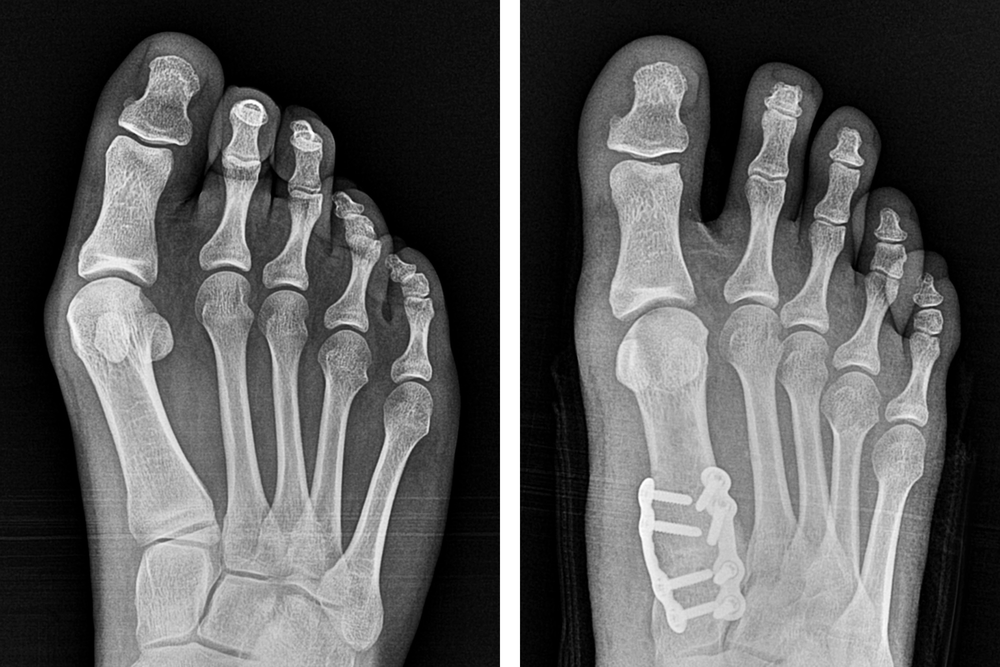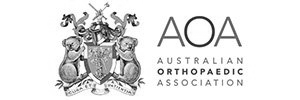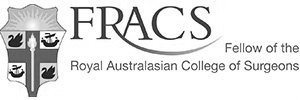Bunion
Surgery
What is Bunion Surgery
Bunion Surgery also referred to as Lapiplasty or Bunionectomy is the only means of correcting a bunion.
Surgery is also recommended when conservative measures fail to treat the symptoms of bunion.
There are many surgical options to treat a bunion. The common goal is to realign the bones in the foot, correct the deformity, and relieve pain and discomfort.
The surgery is performed as a day procedure, under the effect of a light general anaesthetic and a regional nerve block. When you wake up, you will not be in pain and will be able to walk on your foot straight away.
Types of Bunion Osteotomy Surgery
Osteotomy is a common type of bunion surgery that involves the surgical cutting and realignment of the bones around your big toe. Your surgeon selects the appropriate surgical procedure based on the type of bunion and its severity. There are 3 main types of osteotomies used by foot and ankle surgeons
Akin Osteotomy
Akin osteotomy corrects the sideways deviation of the big toe. In this procedure, your surgeon makes a small cut in the proximal phalanx (base of the big toe) and removes a wedge of bone to straighten the big toe. The bony fragments are then stabilized using a screw or staples. This procedure is often used in conjunction with the other procedures below.
Chevron Osteotomy
A chevron osteotomy is usually recommended for mild to moderate bunion deformities. During this procedure, your surgeon will make an incision over your big toe. The joint capsule is opened and the bunion is removed using a surgical saw.
A V-shaped cut is made on your big toe and the metatarsal bones are shifted to bring your toe into its normal anatomical position. The bunion is then shaved and the soft tissues are realigned to correct the position. Akin osteotomy may be performed if necessary. The mobility of your big toe is examined, and the capsule and wound are re-approximated with sutures. Screws or pins are used to hold the bones in their new position until healing.
This procedure can also be performed minimally invasively with keyhole style incisions.
Arthrodesis: Involves fusing the two bones that form the big toe joint. This procedure is used for severe bunions and when arthritis has set in. The movement of your big toe is reduced following this procedure but pain and deformity are very well controlled.
Scarf Osteotomy
Scarf osteotomy is usually recommended for moderate to severe bunion deformities. Your surgeon will make an incision along your big toe and open the joint capsule to expose the bump. The bump on your big toe is then removed using a bone saw.
Your first metatarsal bone is then cut in a Z shape and realigned to correct the deformity. Your surgeon will fix the cut bone with pins or screws. The joint capsule and surgical wounds are then reapproximated using dissolvable sutures keeping your toe in a straight position. This is a very powerful corrective procedure with excellent long term results.
Cheilectomy for Bunion (Hallux-Rigidus)
Cheilectomy is a surgical procedure, performed to remove a bony lump from the big toe of the foot in a medical condition known as Hallux-Rigidus. This bony lump develops on the first metatarsophalangeal joint, which is the main joint of the big toe.
This bony lump develops on the first metatarsophalangeal joint, which is the main joint of the big toe, and the surgery removes this bony lump caused by arthritis.
Minimally Invasive Cheilectomy of the 1st MTPJ
Cheilectomy is a procedure to remove excessive bone from the first metatarsophalangeal joint (MTPJ).
The MPT joints are the junctions between the metatarsal bones (long bones in the foot) and the proximal bones (bone in toes). The first MTPJ refers to the joint in the big toe of the foot. This surgery is intended to treat pain and stiffness and to increase the motion in the joint of the big toe. It may be performed in a minimally invasive manner through a very small incision.
Indications for Minimally Invasive Cheilectomy
Cheilectomy is designed to treat early arthritis and hallux rigidus. The surgery is performed to treat pain, stiffness and limited range of motion in the joint of the big toe which is caused due to arthritis.
Preparation for Bunion Surgery
Once you and the doctor have decided that surgery is required, preparation is necessary to achieve the best results and a quick and problem free recovery.
- Certain medications must be avoided. Your doctor may advise you to refrain from taking medications or dietary supplements that may increase your risk of bleeding.
- Fast beforehand. Depending on the type of anaesthesia you'll be receiving, your doctor may advise you to refrain from eating and drinking six to twelve hours before the procedure.
- Arrange for a ride. You will not be allowed to drive yourself home after the procedure, so make arrangements for someone to pick you up. If you live alone, arrange for someone to check on you that evening or, ideally, to stay with you for the rest of the day.
- Wear loose clothing. If you're having knee surgery, wear loose, comfortable clothing, such as baggy gym shorts and slip-on shoes, so you can easily dress after the procedure.
Returning Home After Bunion Surgery
When you go home you need to take special precautions around the house to make sure it is safe. These may include:
- rails in your bathroom,
- modify your sleeping arrangements (especially if you are sleeping upstairs).
- You will be able to have a shower once the wound is healed, you may shower.
Assess your home situation to ensure you have adequate home support in the first few weeks following surgery. If you live alone it may be necessary to arrange a package of community care to help during the first few weeks at home.
Bunion Surgery Process
Bunion Surgery Rehabilitation Program
Risks & Complications Associated with Bunion Surgery
Surgical Follow Ups
How Risks Are Minimised
Get Moving Quickly
Early mobilisation is a major preventive measure. We strongly encourage you to get moving and out of bed as soon as possible after the operation to restore normal blood flow in the legs.
You should aim to do at least ten short walks (of between 2 and 5 minutes) each day in the first two weeks after surgery.
How Can I Minimise Post Operative Complications
Blood clots (DVT or PE)
All patients receive a number of treatment measures to reduce the risk of blood clots. These include
- Injections of heparin during and after surgery, and
- Sequential calf compression device
As a result of these measures, we have never had a patient develop a deep venous thrombosis. Any patient who is at high risk of a blood clot (such as a history of blood clots or clotting disorders) may be asked to continue heparin (Clexane) injections for 10 days after the surgery in addition to the other measures.
This can be done at home, and we will show you how.
What Are the Consequences of Surgery?
Sometimes the potential risks and consequences of your surgical procedure need to be weighed against the benefits of a successful surgical outcome.
Like most surgery these benefits can include:
- Freedom from pain
- Increase movement
- Greater Flexibility,
- Maintained Independence
- Improved outlook, and
- Longer more enjoyable life
Although the recurrence of the presenting problem is not very common, after surgery, you would need to follow preventive measures.
It is important to avoid high impact activities during the early phase of recovery to minimise the risk of further injury. If there are any postoperative concerns or pain, please do not hesitate in contacting [doctor] or the rooms.






